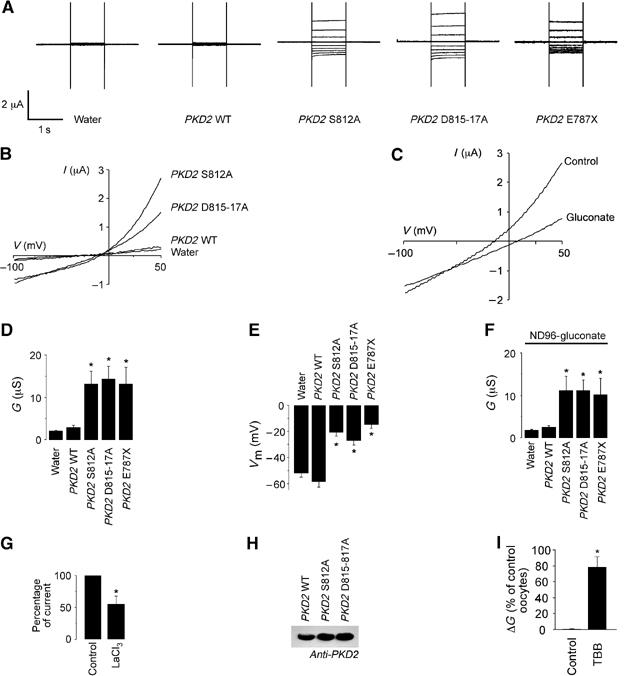Figure 4.

The acidic cluster of polycystin-2 affects whole cell currents in Xenopus oocytes. (A) Measurements of current (I) in oocytes injected with water, PKD2 WT, PKD2 S812A, PKD2 D812-817A and PKD2 E787X. Voltage was clamped between −100 and +60 mV (increments of 20 mV for 1 s). (B) Current–voltage (I–V) relationship of PKD2 WT and mutants. (C) I–V relationship of an oocyte expressing PKD2 S812A after replacement of extracellular Cl− by gluconate. (D) Whole cell conductance (G; determined from −100 to 0 mV) of oocytes injected with water (n=49), PKD2 WT (n=21), PKD2 S812A (n=25), PKD2 D815-817A (n=36) or PKD2 E787X (n=12). In contrast to PKD2 WT, expression of PKD2 mutants with a disrupted PACS-1-binding motif significantly increased the whole cell conductance and (E) depolarized the membrane potential (Vm) of injected oocytes (water n=46, PKD2 WT n=19, PKD2 S812A n=22, PKD2 D815-817A n=35, PKD2 E787X n=12). (F) The whole cell conductance remained significantly increased by the PKD2 mutants in the absence of extracellular chloride (Cl−) (ND96-gluconate) (PKD2 WT n=23, PKD2 S812A n=25, PKD2 D815-817A n=35, PKD2 E787X n=10). (G) Lanthanum (500 μM) partially inhibited the whole cell conductance of oocytes injected with PKD2 S812A (n=10). (H) Equal expression of different PKD2 full-length constructs was confirmed by Western blot (five oocytes were pooled for each condition). (I) Preincubation of oocytes expressing PKD2 WT with the specific CK2 inhibitor TBB (20 μM, 3–6 h) significantly increased the conductance (ΔG) compared to water-injected oocytes treated with TBB. Asterisks indicate statistical significance with P<0.05.
